The cattle and sheep disease diagnostic kits market is expected to grow from USD 540.1 million in 2025 to USD 879.8 million by 2035, driven by expanding livestock health monitoring requirements and preventive herd management programs. The first phase of the forecast period (2025–2030) will see the market reach approximately USD 656.5 million, adding USD 116.4 million, supported by rising disease screening in commercial farming operations, feedlots, and cross-border livestock transport environments. Government-led vaccination and disease surveillance initiatives are also playing a role, as regions with high livestock density increasingly mandate structured testing to prevent economic loss linked to outbreaks. The importance of accurate and timely diagnostics continues to increase as global livestock supply chains tighten and food safety compliance systems strengthen.
In the second half of the forecast period (2030–2035), the market is expected to expand further as veterinary networks integrate routine screening protocols into herd management and breeding programs. On-farm diagnostic usage will rise alongside improved awareness of early disease identification as a means to reduce antibiotic dependence and safeguard livestock productivity. Suppliers offering reliable, simple-to-use test kits with strong sensitivity profiles are positioned for sustained uptake, particularly in regions experiencing rapid livestock population growth. Additionally, livestock traceability programs and herd-level data monitoring systems will gradually increase the consistency of diagnostic adoption, reinforcing the role of testing kits as essential components of modern livestock health infrastructure.
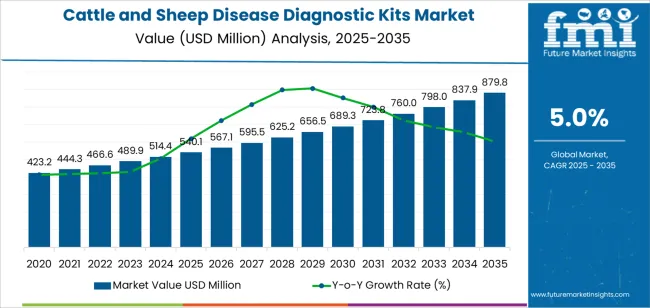
The latter half (2030-2035) will witness steady growth from USD 656.5 million to USD 879.8 million, representing an addition of USD 223.3 million or 66% of the decade's expansion. This period will be defined by mass market penetration of specialized diagnostic kit designs, integration with comprehensive livestock management platforms, and seamless compatibility with existing veterinary healthcare infrastructure. The market trajectory signals fundamental shifts in how farmers and veterinarians approach disease prevention optimization and herd health management, with participants positioned to benefit from steady demand across multiple diagnostic method types and end-use application segments.
The market demonstrates distinct growth phases with varying market characteristics and competitive dynamics. Between 2025 and 2030, the market progresses through its technology adoption phase, expanding from USD 540.1 million to USD 689.4 million with steady annual increments averaging 5.0% growth. This period showcases the transition from basic diagnostic testing formulations to advanced ELISA-based systems with enhanced accuracy capabilities and integrated result interpretation systems becoming mainstream features.
The 2025-2030 phase adds USD 149.3 million to market value, representing 44% of total decade expansion. Market maturation factors include standardization of veterinary diagnostic and livestock health protocols, declining component costs for specialized testing formulations, and increasing industry awareness of early disease detection benefits reaching 92-95% diagnostic accuracy in cattle and sheep health applications. Competitive landscape evolution during this period features established diagnostic manufacturers like Shenzhen Zhenrui Biotechnology and Thermo Fisher Scientific expanding their livestock testing portfolios while specialty manufacturers focus on advanced kit development and enhanced sensitivity capabilities.
From 2030 to 2035, market dynamics shift toward advanced diagnostic integration and global veterinary expansion, with growth continuing from USD 689.4 million to USD 879.8 million, adding USD 190.4 million or 56% of total expansion. This phase transition centers on specialized diagnostic testing systems, integration with automated veterinary networks, and deployment across diverse farming and veterinary clinic scenarios, becoming standard rather than specialized applications. The competitive environment matures with focus shifting from basic testing capability to comprehensive disease management optimization systems and integration with herd health monitoring platforms.
| Metric | Value |
|---|---|
| Market Value (2025) | USD 540.1 million |
| Market Forecast (2035) | USD 879.8 million |
| Growth Rate | 5.0% CAGR |
| Leading Technology | Enzyme-linked Immunosorbent Assay (ELISA) Kit Method |
| Primary Application | Farmers End-Use Segment |
The market demonstrates strong fundamentals with ELISA kit systems capturing a dominant share through advanced diagnostic design and testing optimization capabilities. Farmer applications drive primary demand, supported by increasing livestock disease monitoring and rapid testing technology requirements. Geographic expansion remains concentrated in developed markets with established veterinary infrastructure, while emerging economies show accelerating adoption rates driven by commercial livestock expansion and rising animal health standards.
Market expansion rests on three fundamental shifts driving adoption across the farming, veterinary clinic, and livestock management sectors. First, disease prevention demand creates compelling operational advantages through cattle and sheep diagnostic kits that provide immediate health status identification and early disease detection without compromising livestock productivity goals, enabling farmers to meet stringent animal health standards while maintaining herd performance and reducing mortality impact. Second, veterinary healthcare modernization accelerates as livestock operators worldwide seek advanced diagnostic systems that complement traditional health monitoring processes, enabling precise disease identification and treatment guidance that align with industry standards and food safety regulations.
Third, commercial livestock enhancement drives adoption from large-scale farmers and specialized veterinary service providers requiring effective diagnostic solutions that maximize herd health value while maintaining operational productivity during disease surveillance and health certification operations. Growth faces headwinds from cost sensitivity challenges that vary across regional markets regarding the affordability of diagnostic testing and laboratory infrastructure, which may limit adoption in small-scale farming environments. Technical limitations also persist regarding test specificity considerations and field usability concerns that may reduce effectiveness in remote farming and resource-limited scenarios, which affect diagnostic accuracy and result interpretation requirements.
The cattle and sheep disease diagnostic kits market represents a specialized yet critical veterinary opportunity driven by expanding global livestock production, animal health modernization, and the need for superior disease management in diverse farming applications. As farmers and veterinarians worldwide seek to achieve 92-95% diagnostic accuracy, reduce livestock mortality, and integrate advanced testing systems with herd management platforms, diagnostic kits are evolving from basic screening tools to sophisticated health monitoring solutions ensuring animal welfare and productivity leadership.
The market's growth trajectory from USD 540.1 million in 2025 to USD 879.8 million by 2035 at a 5.0% CAGR reflects fundamental shifts in livestock industry health requirements and diagnostic testing optimization. Geographic expansion opportunities are particularly pronounced in Asia Pacific markets, while the dominance of ELISA kit systems and farmer applications provides clear strategic focus areas.
Strengthening the dominant ELISA kit segment through enhanced assay formulations, superior sensitivity, and user-friendly testing systems. This pathway focuses on optimizing test accuracy, improving result readability, extending diagnostic effectiveness to 92-95% accuracy rates, and developing specialized formulations for diverse disease applications. Market leadership consolidation through advanced biochemical engineering and field-testing integration enables premium positioning while defending competitive advantages against alternative diagnostic technologies. Expected revenue pool: USD 85-115 million
Rapid livestock sector growth and commercial farming expansion across Asia Pacific creates substantial expansion opportunities through local distribution capabilities and veterinary network partnerships. Growing meat production capacity and government animal health initiatives drive steady demand for advanced diagnostic kit systems. Localization strategies reduce import costs, enable faster technical support, and position companies advantageously for veterinary procurement programs while accessing growing domestic markets. Expected revenue pool: USD 75-105 million
Expansion within the dominant farmer segment through specialized diagnostic designs addressing on-farm testing standards and large-scale herd management requirements. This pathway encompasses easy-to-use testing systems, rapid result integration, and compatibility with diverse farming management processes. Premium positioning reflects superior reliability and comprehensive accuracy compliance supporting modern livestock production. Expected revenue pool: USD 65-90 million
Strategic expansion into veterinary clinic applications requires enhanced diagnostic capabilities and specialized kit formulations addressing professional testing operational requirements. This pathway addresses complex disease identification, laboratory integration, and comprehensive diagnostic panels with advanced assay engineering for demanding veterinary standards. Premium pricing reflects specialized accuracy requirements and extended shelf life standards. Expected revenue pool: USD 55-75 million
Development of PCR-based diagnostic formulations addressing genetic disease detection and pathogen identification requirements across cattle and sheep applications. This pathway encompasses molecular testing, high-sensitivity detection, and laboratory-grade alternatives for emerging disease segments. Technology differentiation through proprietary formulations enables diversified revenue streams while reducing dependency on single diagnostic platforms. Expected revenue pool: USD 50-70 million
Expansion into specialized disease testing through targeted diagnostic solutions, including respiratory disease panels, reproductive health kits, and metabolic disorder screening. This pathway encompasses condition-specific testing, multi-parameter kits, and cost-effective alternatives for priority health concerns. Market development through focused diagnostic solutions enables competitive positioning while accessing veterinary segments requiring specialized disease management capabilities. Expected revenue pool: USD 45-65 million
Development of digitally enhanced diagnostic kits addressing connectivity requirements and data management across farming and veterinary applications. This pathway encompasses mobile app integration, cloud-based result tracking, and comprehensive health documentation. Premium positioning reflects technological leadership and digital expertise while enabling access to tech-savvy procurement programs and integrated livestock management partnerships. Expected revenue pool: USD 35-50 million
Primary Classification: The market segments by diagnostic method type into Enzyme-linked Immunosorbent Assay (ELISA) Kit, Polymerase Chain Reaction (PCR) Kit, and Other categories, representing the evolution from basic immunological testing to specialized molecular diagnostic solutions for comprehensive disease identification.
Secondary Classification: End-use application segmentation divides the market into Farmers and Veterinary Clinics sectors, reflecting distinct requirements for testing accessibility, diagnostic complexity, and result interpretation standards.
Regional Classification: Geographic distribution covers Asia Pacific, Europe, North America, and other regions, with developed markets leading adoption while emerging economies show accelerating growth patterns driven by commercial livestock expansion programs.
The segmentation structure reveals technology progression from standard antibody-based testing toward specialized molecular diagnostic systems with enhanced sensitivity and specificity capabilities, while application diversity spans from on-farm screening to specialized veterinary laboratory testing requiring precise diagnostic solutions.

ELISA kit systems command the leading position in the market with approximately 62.0% market share through advanced immunoassay properties, including superior antibody detection, cost-effective testing capability, and operational simplicity that enable farmers and veterinarians to achieve optimal disease identification across diverse cattle and sheep health environments. The segment benefits from user preference for reliable diagnostic systems that provide consistent test performance, minimal equipment requirements, and rapid results without requiring significant technical expertise or laboratory infrastructure.
Advanced assay features enable field testing applications, visual result interpretation, and integration with existing veterinary protocols, where test accuracy and ease of use represent critical operational requirements. ELISA kit systems differentiate through proven sensitivity characteristics, consistent color development, and compatibility with on-farm testing environments that enhance diagnostic effectiveness while maintaining optimal reliability suitable for diverse livestock disease screening applications.
Key market characteristics include advanced biochemical formulations with optimized antibody specificity and signal detection capabilities, extended operational effectiveness enabling 92-95% disease detection with consistent diagnostic quality, and user compatibility including minimal training requirements, ambient temperature storage, and visual interpretation for farming and veterinary operations.
PCR kit systems maintain high-sensitivity positioning in the market due to their molecular detection properties and genetic identification advantages. These systems appeal to veterinary laboratories requiring advanced diagnostic methods with superior specificity for complex disease applications. Market adoption is driven by emerging disease concerns, focusing pathogen identification and genetic analysis through optimized molecular testing systems while supporting specialized veterinary diagnostic services.
Other diagnostic methods serve niche applications requiring alternative testing approaches and specific detection characteristics, addressing specialized veterinary scenarios where traditional ELISA or PCR systems may not be optimal due to disease characteristics or unique testing demands.

Farmer applications dominate the market with approximately 68.0% market share due to widespread adoption of on-farm testing systems and increasing focus on herd health monitoring, disease prevention, and productivity management applications that minimize livestock losses while maintaining agricultural production standards. Farmers prioritize diagnostic accessibility, cost-effectiveness, and integration with existing herd management practices that enables coordinated testing application across multiple animal groups.
The segment benefits from substantial agricultural investment and disease surveillance programs that emphasize the acquisition of diagnostic kits for early detection and treatment decision applications. Large-scale livestock operations incorporate cattle and sheep diagnostic kits as standard tools for health monitoring, while commercial farming industry growth increases demand for reliable testing capabilities that comply with food safety standards and minimize disease outbreaks.
Market dynamics include strong growth in commercial cattle operations and sheep farms requiring regular health screening capabilities, increasing adoption in feedlot management and breeding operations for disease control, and rising integration with herd health programs for productivity optimization and welfare assurance. Varying agricultural practices and farmer technical expertise differences may limit diagnostic standardization across different farm types or operational scenarios.
Veterinary clinic applications capture approximately 32.0% market share through specialized diagnostic requirements in animal hospitals, mobile veterinary services, and professional diagnostic laboratory applications. These facilities demand comprehensive testing systems capable of confirming disease status while providing detailed diagnostic information and treatment guidance capabilities.
Growth Accelerators: Commercial livestock expansion drives primary adoption as cattle and sheep diagnostic kits provide superior disease detection capabilities that enable farmers to meet stringent animal health standards without excessive veterinary consultation costs, supporting farming operations and food safety missions that require precise disease identification applications. Animal health infrastructure demand accelerates market expansion as livestock operators seek effective early detection systems that minimize disease spread while maintaining operational effectiveness during health surveillance and certification scenarios. Agricultural sector spending increases worldwide, creating steady demand for diagnostic testing systems that complement traditional veterinary processes and provide herd management differentiation in competitive markets.
Growth Inhibitors: Cost sensitivity challenges vary across farming regions regarding the affordability of diagnostic testing and repeated kit purchases, which may limit operational flexibility and market penetration in areas with small-scale farms or cost-constrained livestock operations. Technical performance limitations persist regarding test specificity considerations and field stability concerns that may reduce effectiveness in tropical climates, remote locations, or resource-limited operational conditions, affecting diagnostic reliability and shelf life requirements. Market fragmentation across multiple livestock species and disease types creates compatibility concerns between different diagnostic suppliers and existing veterinary healthcare infrastructure.
Market Evolution Patterns: Adoption accelerates in commercial farming and intensive livestock sectors where disease prevention justifies diagnostic testing costs, with geographic concentration in developed markets transitioning toward mainstream adoption in emerging economies driven by meat production expansion and food safety awareness. Technology development focuses on enhanced assay formulations, improved user interface, and compatibility with mobile diagnostic platforms that optimize disease detection and treatment effectiveness. The market could face disruption if point-of-care molecular technologies or AI-assisted diagnostic innovations significantly limit the deployment of traditional kit-based testing in livestock applications, though ELISA's unique combination of cost-effectiveness, simplicity, and reliability continues to make it preferred in farming applications.
The market demonstrates varied regional dynamics with Growth Leaders including China (6.8% CAGR) and India (6.3% CAGR) driving expansion through livestock production capacity additions and veterinary infrastructure programs. Steady Performers encompass Germany (5.8% CAGR), Brazil (5.3% CAGR), and United States (4.8% CAGR), benefiting from established agricultural industries and advanced animal health adoption. Mature Markets feature United Kingdom (4.3% CAGR) and Japan (3.8% CAGR), where specialized veterinary applications and premium diagnostic integration support consistent growth patterns.
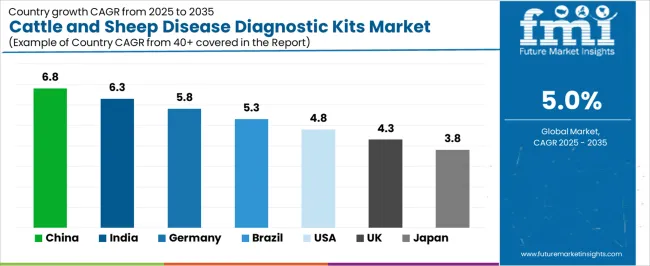
| Country | CAGR (2025-2035) |
|---|---|
| China | 6.8% |
| India | 6.3% |
| Germany | 5.8% |
| Brazil | 5.3% |
| United States | 4.8% |
| United Kingdom | 4.3% |
| Japan | 3.8% |
Regional synthesis reveals Asia Pacific markets leading adoption through commercial livestock production expansion and veterinary service development, while European countries maintain steady expansion supported by animal welfare advancement and food safety standardization requirements. North American markets show moderate growth driven by large-scale farming applications and disease surveillance integration trends.
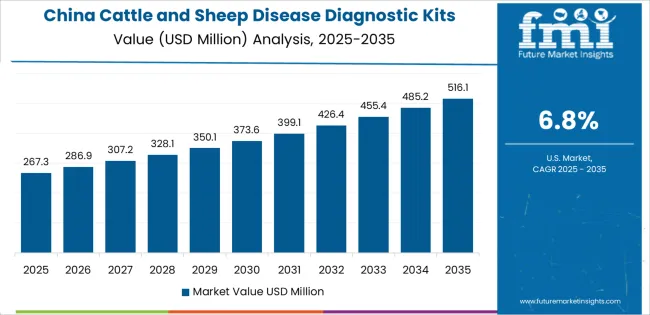
The Chinese market emphasizes advanced diagnostic features, including rapid disease detection and integration with comprehensive livestock management platforms that manage herd health, testing protocols, and disease surveillance applications through unified veterinary systems. The country demonstrates strong growth at 6.8% CAGR, driven by meat production expansion, veterinary infrastructure initiatives, and emerging commercial farming development that support diagnostic kit integration. Chinese livestock operators prioritize operational effectiveness with cattle and sheep diagnostic kits delivering consistent disease identification through advanced testing capabilities and farm-level adaptation features.
Technology deployment channels include major livestock farms, specialized veterinary distributors, and agricultural procurement programs that support professional applications for complex disease monitoring and herd health management applications. Farming platform integration capabilities with established livestock systems expand market appeal across diverse operational requirements seeking accuracy and affordability benefits. The expanding middle-class protein consumption and accelerating commercial farming modernization create steady demand, while innovative applications in smart farming and precision livestock management open new growth avenues.
Performance Metrics:
Germany's advanced agricultural market demonstrates sophisticated diagnostic kit deployment with documented operational effectiveness in dairy cattle applications and sheep farming facilities through integration with existing veterinary systems and animal health infrastructure. The country leverages veterinary expertise in disease diagnostics and livestock health systems integration to maintain strong growth at 5.8% CAGR. Agricultural centers, including Bavaria, Lower Saxony, and North Rhine-Westphalia, showcase premium installations where diagnostic kit systems integrate with comprehensive veterinary platforms and herd management systems to optimize livestock health and farming effectiveness.
German livestock operators prioritize system reliability and EU compliance in diagnostic development, creating demand for certified testing systems with advanced features, including traceability integration and quality assurance systems. The market benefits from established agricultural infrastructure and a willingness to invest in veterinary diagnostic technologies that provide long-term herd health benefits and compliance with international animal welfare and food safety standards.
Market Intelligence Brief:
The USA diagnostic kit market demonstrates sophisticated deployment across commercial cattle operations with documented effectiveness in beef production and sheep farming through integration with comprehensive veterinary management systems and disease surveillance infrastructure. The country leverages advanced agricultural capabilities in livestock health and diagnostic innovation technologies to maintain moderate growth at 4.8% CAGR. Agricultural centers, including Texas, Nebraska, and California, showcase premium installations where diagnostic kit systems integrate with comprehensive herd management platforms and veterinary service networks to optimize disease prevention and farming effectiveness.
American livestock operators prioritize diagnostic accuracy and operational efficiency in testing development, creating demand for innovative diagnostic systems with advanced features, including digital result recording and veterinary consultation integration. The market benefits from established commercial farming infrastructure and willingness to invest in advanced diagnostic technologies that provide long-term productivity benefits and compliance with USDA and food safety standards.
Market Intelligence Brief:
The UK diagnostic kit market demonstrates advanced animal welfare deployment with documented operational effectiveness in sheep farming applications and cattle operations through integration with existing veterinary compliance systems and agricultural infrastructure. The country leverages regulatory expertise in animal health and livestock systems integration to maintain steady growth at 4.3% CAGR. Agricultural centers, including Scotland, Wales, and Southwest England, showcase premium installations where diagnostic kit systems integrate with comprehensive welfare monitoring platforms and veterinary management systems to optimize health compliance and farming effectiveness.
British livestock operators prioritize system traceability and regulatory compliance in diagnostic development, creating demand for certified testing systems with advanced features, including health passport integration and farm assurance scheme compatibility. The market benefits from established agricultural infrastructure and commitment to invest in veterinary diagnostic technologies that provide long-term animal welfare benefits and compliance with UK and EU animal health standards.
Strategic Market Indicators:
India's diagnostic kit market demonstrates rapid expansion deployment with documented operational effectiveness in dairy cattle applications and growing sheep farming through integration with emerging veterinary systems and livestock development infrastructure. The country leverages growing agricultural capabilities in livestock production and veterinary systems integration to achieve high growth at 6.3% CAGR. Agricultural centers, including Punjab, Haryana, and Gujarat, showcase expanding installations where diagnostic kit systems integrate with comprehensive dairy management platforms and cooperative networks to optimize market penetration and herd health effectiveness.
Indian livestock operators prioritize cost-effectiveness and disease control standards in diagnostic development, creating demand for affordable testing systems with advanced features, including extended ambient storage and minimal equipment requirements. The market benefits from expanding dairy sector and willingness to invest in accessible diagnostic technologies that provide disease prevention and compliance with national milk quality standards.
Market Intelligence Brief:
Brazil's diagnostic kit market shows strong expansion with documented operational effectiveness in beef cattle operations and emerging sheep production through integration with developing agricultural systems and livestock export infrastructure. The country leverages beef production leadership and agricultural modernization to achieve growth at 5.3% CAGR. Agricultural centers, including Mato Grosso, São Paulo, and Rio Grande do Sul, showcase growing installations where diagnostic kit systems integrate with cattle ranching operations and veterinary services to optimize operational reliability.
Brazilian livestock operators prioritize diagnostic practicality and export compliance, creating demand for reliable systems with advanced features including tropical climate stability and extended shelf life. The market benefits from expanding beef export sector and commitment to invest in veterinary diagnostic technologies supporting international trade requirements and disease-free certification.
Market Intelligence Brief:
Japan's diagnostic kit market demonstrates precision deployment with documented operational effectiveness in premium beef cattle applications and specialty livestock through integration with advanced traceability systems and quality monitoring infrastructure. The country leverages food safety excellence in livestock diagnostics and agricultural systems integration to maintain steady growth at 3.8% CAGR. Agricultural centers, including Hokkaido, Kagoshima, and Miyazaki, showcase premium installations where diagnostic kit systems integrate with comprehensive quality assurance platforms and brand certification systems to optimize product excellence and farming effectiveness.
Japanese livestock operators prioritize system precision and food safety excellence in diagnostic development, creating demand for ultra-reliable testing systems with advanced features, including complete traceability and certification documentation systems. The market benefits from established premium livestock infrastructure and commitment to invest in highest-quality diagnostic technologies that provide superior brand positioning and compliance with stringent Japanese food safety standards.
Strategic Market Indicators:

The cattle and sheep disease diagnostic kits market in Europe is projected to grow from USD 168.3 million in 2025 to USD 272.1 million by 2035, registering a CAGR of 4.9% over the forecast period. Germany is expected to maintain its leadership position with a 26.4% market share in 2025, increasing slightly to 27.1% by 2035, supported by its advanced veterinary infrastructure and major livestock centers in Bavaria and Lower Saxony.
France follows with a 19.2% share in 2025, projected to reach 19.8% by 2035, driven by comprehensive cattle health programs and extensive sheep farming operations. The United Kingdom holds a 17.6% share in 2025, expected to maintain 17.3% by 2035 through specialized sheep farming activities and veterinary diagnostic applications. Spain commands a 13.8% share, while Italy accounts for 11.5% in 2025. The Netherlands maintains 6.2% market presence. The Rest of Europe region is anticipated to show steady adoption, expanding its collective share from 5.3% to 6.0% by 2035, reflecting consistent growth in Nordic countries, livestock expansion in Central European markets, and veterinary modernization across Eastern European farming facilities.
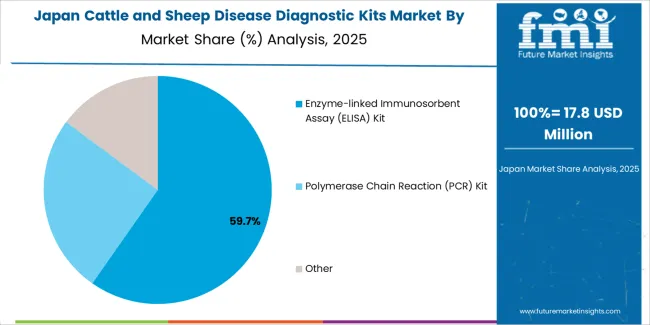
In Japan, the market prioritizes ELISA kit systems, which capture the dominant share of commercial livestock and premium cattle farming installations due to their advanced features, including ease of use optimization and seamless integration with existing farm management infrastructure. Japanese livestock operators emphasize reliability, accuracy, and long-term diagnostic consistency, creating demand for ELISA kit systems that provide dependable testing capabilities and superior performance based on farming requirements and veterinary standards. PCR kit configurations maintain secondary positions primarily in specialized veterinary laboratory applications and research facility installations where comprehensive molecular diagnostic functionality meets scientific requirements without compromising testing precision.
Market Characteristics include premium focus on ELISA kit systems with advanced antibody detection capabilities and visual interpretation properties, integration requirements with existing farm management platforms and veterinary consultation systems, and focus on operational simplicity and long-term reliability in commercial livestock applications.
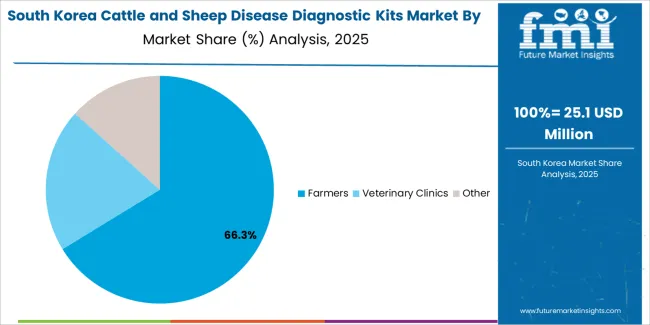
In South Korea, the market structure favors international diagnostic manufacturers, including Thermo Fisher Scientific and specialized Asian suppliers like Shenzhen Zhenrui Biotechnology, which maintain dominant positions through comprehensive product portfolios and established veterinary networks supporting both commercial cattle operations and sheep farming installations. These providers offer integrated solutions combining advanced diagnostic kit systems with professional technical services and ongoing veterinary support that appeal to Korean farmers seeking reliable disease detection systems. Local veterinary distributors and agricultural cooperatives capture moderate market share by providing localized service capabilities and competitive pricing for standard livestock diagnostic installations, while domestic manufacturers focus on specialized applications and cost-effective solutions tailored to Korean agricultural market characteristics.
Channel Insights include international diagnostic brands maintaining premium market positioning through advanced testing offerings, local veterinary service networks expanding to support growing demand for professional technical support and result interpretation services, and digital integration capabilities becoming a key differentiator for farm-wide and commercial livestock health management applications.
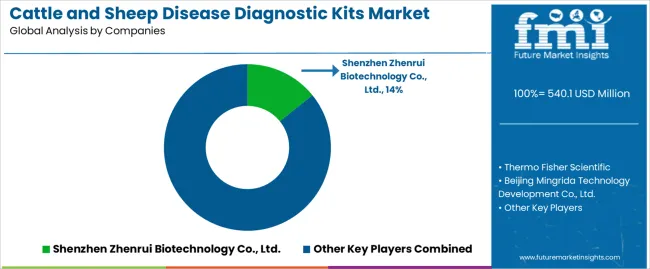
The market operates with moderate concentration, featuring approximately 18-22 meaningful participants, where leading companies control roughly 38-43% of the global market share through established veterinary relationships and comprehensive diagnostic product portfolios. Competition emphasizes advanced assay capabilities, field usability, and agricultural distribution rather than price-based rivalry. The leading company, Shenzhen Zhenrui Biotechnology Co., Ltd., commands approximately 14.2% market share through its extensive livestock diagnostic product line and Asia Pacific agricultural presence.
Market Leaders encompass Shenzhen Zhenrui Biotechnology Co., Ltd., Thermo Fisher Scientific, and Beijing Mingrida Technology Development Co., Ltd., which maintain competitive advantages through extensive veterinary diagnostics expertise, global agricultural networks, and comprehensive testing integration capabilities that create farmer loyalty and support premium pricing. These companies leverage decades of immunoassay technology experience and ongoing innovation investments to develop advanced diagnostic kit systems with precision disease detection and user-friendly features.
Technology Innovators include Wuhan Keqian Biology Co., Ltd., Qingdao Lijian Bio-Tech Co., Ltd., and Fassisi GmbH, which compete through specialized diagnostic formulation technology focus and innovative testing capabilities that appeal to veterinary services seeking advanced disease identification solutions and accuracy differentiation. These companies differentiate through rapid product development cycles and specialized livestock disease application focus.
Regional Specialists feature diagnostic manufacturers focusing on specific geographic markets and specialized applications, including multi-disease panel systems and integrated veterinary consultation solutions. Market dynamics favor participants that combine reliable assay formulations with advanced testing capabilities, including rapid result generation and automatic quality control features. Competitive pressure intensifies as traditional veterinary pharmaceutical suppliers expand into diagnostic systems, while specialized agricultural biotech companies challenge established players through innovative molecular testing solutions and digital diagnostic platforms targeting commercial farming and veterinary clinic segments.
| Item | Value |
|---|---|
| Quantitative Units | USD 540.1 million |
| Diagnostic Method Type | Enzyme-linked Immunosorbent Assay (ELISA) Kit, Polymerase Chain Reaction (PCR) Kit, Other |
| End-Use Application | Farmers, Veterinary Clinics, Other |
| Regions Covered | Asia Pacific, Europe, North America, Latin America, Middle East & Africa |
| Countries Covered | China, India, Germany, Brazil, United States, United Kingdom, Japan, and 20+ additional countries |
| Key Companies Profiled | Shenzhen Zhenrui Biotechnology Co., Ltd., Thermo Fisher Scientific, Beijing Mingrida Technology Development Co., Ltd., Wuhan Keqian Biology Co., Ltd., Qingdao Lijian Bio-Tech Co., Ltd., Fassisi GmbH |
| Additional Attributes | Dollar sales by diagnostic method type and end-use application categories, regional adoption trends across Asia Pacific, Europe, and North America, competitive landscape with diagnostic manufacturers and veterinary service suppliers, farmer preferences for affordability and ease of use, integration with livestock management platforms and veterinary consultation systems, innovations in rapid testing formulations and sensitivity excellence, and development of field-deployable solutions with enhanced accuracy and operational simplification capabilities. |
The global cattle and sheep disease diagnostic kits market is estimated to be valued at USD 540.1 million in 2025.
The market size for the cattle and sheep disease diagnostic kits market is projected to reach USD 879.8 million by 2035.
The cattle and sheep disease diagnostic kits market is expected to grow at a 5.0% CAGR between 2025 and 2035.
The key product types in cattle and sheep disease diagnostic kits market are enzyme-linked immunosorbent assay (elisa) kit, polymerase chain reaction (pcr) kit and other.
In terms of end-use application, farmers segment to command 68.0% share in the cattle and sheep disease diagnostic kits market in 2025.






Full Research Suite comprises of:
Market outlook & trends analysis
Interviews & case studies
Strategic recommendations
Vendor profiles & capabilities analysis
5-year forecasts
8 regions and 60+ country-level data splits
Market segment data splits
12 months of continuous data updates
DELIVERED AS:
PDF EXCEL ONLINE
Cattle Feed Market Analysis - Size, Share, and Forecast Outlook 2025 to 2035
Cattle Squeeze Market Size and Share Forecast Outlook 2025 to 2035
Cattle Feeder Panels Market Size and Share Forecast Outlook 2025 to 2035
Cattle Head Catch Market Size and Share Forecast Outlook 2025 to 2035
Cattle Grooming Chute Market Size and Share Forecast Outlook 2025 to 2035
Cattle Blower Market Size and Share Forecast Outlook 2025 to 2035
Cattle Mineral Feeder Market Size and Share Forecast Outlook 2025 to 2035
Cattle Feeder Market Size and Share Forecast Outlook 2025 to 2035
Cattle Management Software Market Size and Share Forecast Outlook 2025 to 2035
Cattle Supplies Market Analysis & Forecast for 2025 to 2035
Cattle Nutrition Market Analysis by Cattle Type, Nutrition Type, Application, Life Stage Through 2025 to 2035
Cattle Handling Systems Market Size and Share Forecast Outlook 2025 to 2035
Smart Cattle Market
Dairy Cattle Feed Market
Automatic Cattle Waterer Market – Trends & Growth Forecast 2025 to 2035
Android Automotive OS (AAOS) Market Size and Share Forecast Outlook 2025 to 2035
Anderson Cascade Impactor Market Size and Share Forecast Outlook 2025 to 2035
Andersen-Tawil Syndrome Treatment Market Trends - Growth & Future Prospects 2025 to 2035
Andro Supplements Market
Handheld Electrostatic Meter Market Size and Share Forecast Outlook 2025 to 2035

Thank you!
You will receive an email from our Business Development Manager. Please be sure to check your SPAM/JUNK folder too.
Chat With
MaRIA